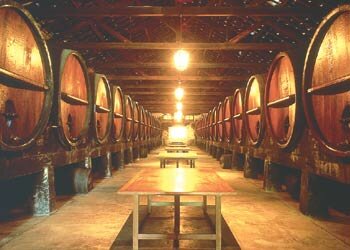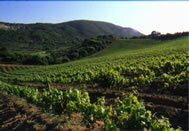
Wine Route of Costa Azul

The wine route of Costa Azul (area known as “blue coast”)
is all about the contact of wine with the sea. The route was mapped
out in 1999/2000 and includes Azeitão, Palmela,
Quinta do Anjo and Pegões. These lands are fertile and include
Moscatel and Periquita varieties. Periquita is the Setúbal
designation for the recognised Castelão Francês variety.
Moscatel de Setúbal, a fortified golden-coloured wine,
with a light aroma and delicate flavour, is produced between Setúbal
and Palmela, whose vineyards were praised in the time of King D.
Dinis. Wines that were produced in the southern region of the Tejo
Valley, in the district of Setúbal, and are not DOC classified,
are called Regional Wines of Terras do Sado.
Wine tasting
The location of choice for wine tasting is Pousada de Palmela,
a classy hotel built inside Palmela Castle. Another location
is Casa Mãe, at Largo de S. João em Palmela, an
old wine cellar transformed by Rota do Vinho into a wine tasting
room, where visitors are also received and welcomed.
Designation of Controlled Origin - DCO
(Denominações de Origem Controlada - DOC)
Setúbal
Palmela
Grape Varieties
Recommended white grape varieties include Fernão Pires,
Arinto, Moscatel de Setúbal, Moscatel de Bago Miúdo,
Moscatel Roxo, Síria, Rabo de Ovelha, Tamarez and Vital.
Some varieties used for Moscatel are: Moscatel de Setúbal,
Moscatel de Jesus, Moscatel de Málaga, Moscatel Romano,
Moscatel roxo da madeira, Moscatel roxo de Constança and
Moscatel do Douro.
The recommended red varieties include Castelão Francês
(Periquita), Alfrocheiro-Preto, Bastardo, Cabernet-Sauvignon and
Trincadeira-Preta.
Regional Wine
Terras do Sado
Events
Festas das Vindimas em Palmela
This festival takes place in September and includes processions
allusive to wine harvesting and a procession of camponeses, or
rural workers, who transport baskets filled with fresh grapes,
ready to be pressed. The grape pressing takes place in a tank in
Igreja de S. Pedro and is followed by a blessing of the mash ceremony.
The festival is very interesting on an ethnographical and tourist
level and attracts many visitors.
Festival Queijo, Pão e Vinho
Sheep shearing, Azeitão cheese making, the most recently
produced wine, and bread baked in a wooden stove are all part of
the local traditions and cultural heritage that are preserved in
this festival, which takes place at Quinta do Anjo, in April.
Mostra de Vinhos da Marateca e Poceirão
This wine festival, held in Fernado Pó in May, is held
to show visitors the quality of the region’s wines. Some
30 producers take part.
Quintas e Palácios de Azeitão
These palaces, manorhouses and estates in Azeitão are all
magnificent, as are those in the villages of Piedade, São
Pedro, Portela, Aldeia de Irmãos, Oleiros, Brejos, Castanhos,
Pinheiros and Vendas de Azeitão. Estates of particular interest
include Palácio dos Duques de Aveiro, Quinta da Bacalhoa,
Quinta das Baldrucas, Quinta da Bassaqueira, Quinta da Palhavã,
Quinta da Má Partilha, Quinta das Torres (Renaissance villa
from 1521), Quinta do Peru e da Conceição and Quinta
de El Carmen.
Castelo de Palmela
This castle is of fascinating military construction and is located
at a strategic place that offers magnificent views of the whole
area. The castle is currently partly occupied by a magnificent
Pousada, whose wine cellars are recognised for its quality and
variety of wines. Chatting with the wine waiter is a good starting
point to discover the region’s wine.
Parque Natural da Arrábida
The Parque Natural da Arrábida is 35 kilometres long and
covers almost 11 thousand hectares, divided amongst the districts
of Setúbal, Palmela, and Sesimbra; it stretches from the
foothills of Palmela to Cabo Espichel, which features Santuário
de Nossa Senhora do Cabo. It has three botanical and natural parks:
Mata Coberta, Reserva do Solitário, Reserva dos Vidais.
Then there is the wildlife park on the Ilhéu da Pedra da
Anixa, situated in the small cove of Portinho da Arrábida
beach.
Moinhos de maré do Estuário do Tejo
These tidal mills were built for grinding cereal before the invention
of steam machines and use the rising of the tides in the estuary
to make the heavy millstones turn. Some are in ruins, others not.
They are to be found mostly in the districts of Seixal and Barreiro
and also in Montijo and Alcochete.
Igreja do antigo Mosteiro de Jesus
This is the most important monument of the city of Setúbal.
It was finished in 1500, and later subjected to renovations and
extensions. The inside features walls decorated with 18 multicoloured
tile panels from the 16th and 17th centuries, which depict scenes
from the life of the Virgin Mary, the main altar’s gilded
woodcarvings, the crypt, the chapterhouse, the sacristy’s
Manueline arch, a relic gold pyx and some interesting paintings
at the chancel.

..top..
|